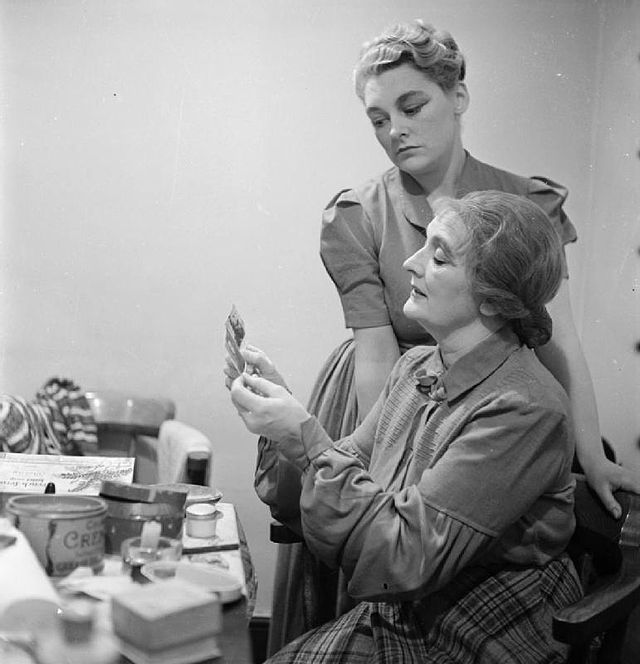Perhaps it was the darkness of the war years that drew people to the lightness and creativity of British theatre. Although what some have called a period of ‘modernism’ started years before the 1940s – in fact, elements of modernist approaches to art, design and theatre can be traced to the period between the two world wars. The people of 1930s Britain experienced terrible hardship, with soaring unemployment and poverty. Yet a group known as The Workers’ Theatre Movement – founded in 1926 – was driven by a belief in the transformative potential of theatre. By 1936 it was integral to the establishment of the Unity Theatre, a group that staged plays on social and political issues to growing audiences. The Unity Theatre stated its aims as:
‘To foster and further the art of drama in accordance with the principle that true art, by effectively presenting and truthfully interpreting life as experienced by the majority of people, can move the people to work for the betterment of society.‘
The group attracted well-known actors, such as pioneering black American actor and singer Paul Robeson, who turned down a starring West End role to appear in a Unity performance in 1938.
And so, during the Second World War years, this interest in the arts continued. Many civilian and military audiences experienced drama, opera, and ballet for the first time. War-time entertainment was seen as crucial for maintaining the morale among the troops and the Entertainments National Services Association (ENSA) were doing great work in that area. But then in 1940 CEMA, the Council for the Encouragement of Music and Arts, was set up, with a mission to focus on the home front. It wasn’t only the troops who needed morale boosting. Britain was fighting to upload its way of life, and it was felt that rather than the traditional music hall performances of the time, theatre should offer something uplifting and educational.
The creation of CEMA (which after the war CEMA went on to be renamed the Arts Council of Great Britain) was the first time the state had funded the arts and seen by some as…
‘the most forward step in the advancement of British culture that a British Government has yet taken’
Heinrich, Anselm. “Theatre in Britain during the Second World War.” New Theatre Quarterly (2010): n. pag. Print. https://www.academia.edu/583469/Theatre_in_Britain_during_the_Second_World_War

During the Blitz in September/October 1940 – a period of bombing that continued for fifty-seven consecutive nights – theatres in the West End were badly damaged. As well as the terrifying loss of life – some 40,000 civilians were killed – and destruction of property – one million houses in London were destroyed – two theatres – the Queens Theatre and the Piccadilly Theatre took direct hits and several others were badly damaged from debris. But those that were able continued to open.
Such was the support and interest from the public, that in 1941 Sunday opening of theatres was discussed by Parliament – the first time in three hundred years that such a thing had happened. Although the government lost the argument – by just eight votes – it showed how popular the concept was.
CEMA went on to support amateur and professional theatre, music and art. The economist, John Maynard Keynes, chaired the organisation from 1942 to 1946. He wanted to take the arts to new audiences, with CEMA organising concerts featuring classical music and drama, and ballet.
And when the war ended in 1945, it seemed that the need for escapism was as vibrant as ever, with one commentator reporting:
‘Every theatre in the West End is packed out every night and to get reserved seats, one has to book weeks ahead.’
Austerity Britain, by David Kynaston
London wasn’t the only place to experience a surge in interest in the arts. In 1947 the first Edinburgh Festival was held, with an explosion of alternative theatre with ‘The Fringe’ getting its name in 1948.
But John Maynard Keynes’ hope of taking arts to the masses wasn’t so easily achieved, with a report from one of the Arts Council’s regional offices stating that there was a ‘failure to establish contact with the ordinary folk in their towns.’
Censorship played a part in limiting the type of theatre performances, with strong support for Shakespeare and traditional plays, such as those by Noel Coward, but little in the way of drama that dealt with contemporary issues.
As Britain moved into a new decade, so too the arts began to see significant change, but more of that in future posts.
Reblogged this on Isabella Muir and commented:
No surprise that people’s desire for escapism was as fervent as ever when the Second World War ended – theatres across Britain were packed out!
LikeLike